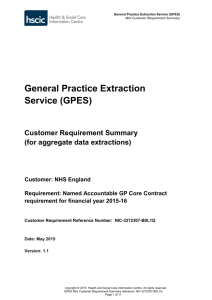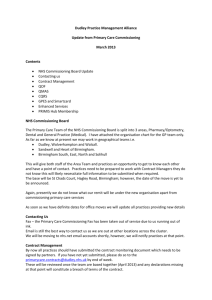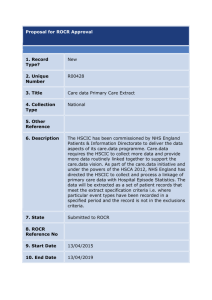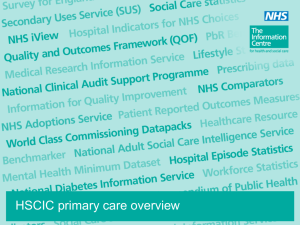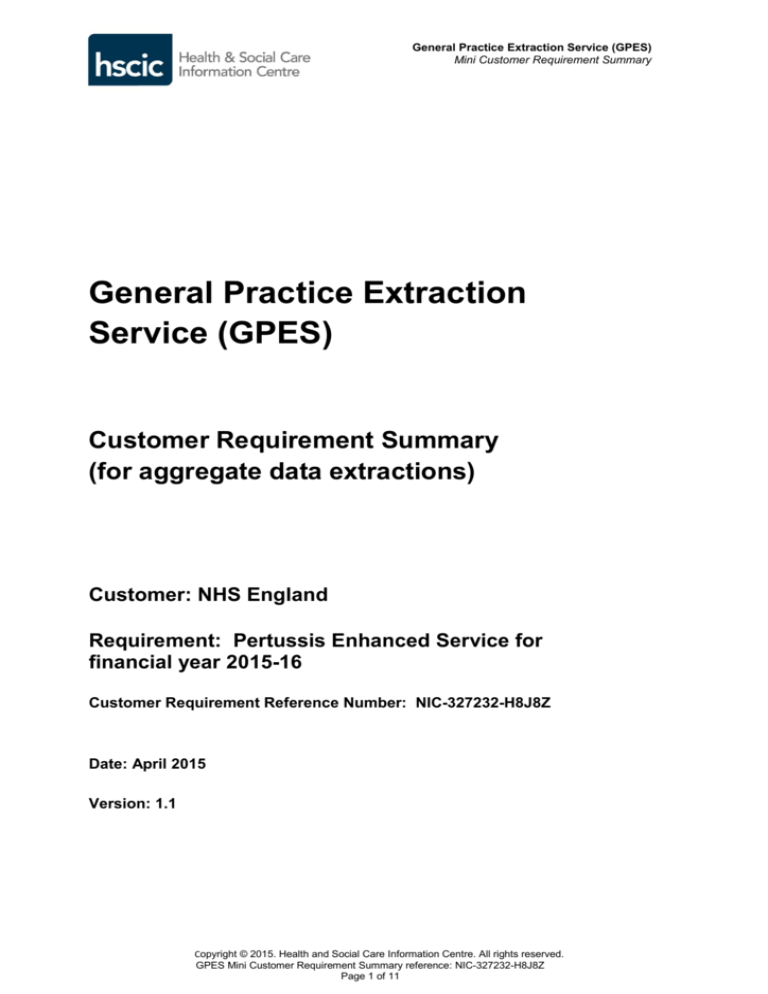
General Practice Extraction Service (GPES)
Mini Customer Requirement Summary
7
General Practice Extraction
Service (GPES)
Customer Requirement Summary
(for aggregate data extractions)
Customer: NHS England
Requirement: Pertussis Enhanced Service for
financial year 2015-16
Customer Requirement Reference Number: NIC-327232-H8J8Z
Date: April 2015
Version: 1.1
Copyright © 2015. Health and Social Care Information Centre. All rights reserved.
GPES Mini Customer Requirement Summary reference: NIC-327232-H8J8Z
Page 1 of 11
General Practice Extraction Service (GPES)
Mini Customer Requirement Summary
Contents
1.
Customer Requirement Summary ......................................................................... 3
2.
Information requirements ....................................................................................... 6
3.
Data management ................................................................................................. 7
2.
Appendix A – Acronyms ........................................................................................ 8
3.
Appendix B – Definitions ....................................................................................... 9
4.
Appendix C – Data delivery process .................................................................... 11
Copyright © 2015. Health and Social Care Information Centre. All rights reserved.
GPES Mini Customer Requirement Summary reference: NIC-327232-H8J8Z
Page 2 of 11
General Practice Extraction Service (GPES)
Mini Customer Requirement Summary
1. Customer Requirement Summary
1.1 Overview
This customer requirement supports the Pertussis Enhanced Service for financial
year 2015-16, which has not previously been considered by the GPES Independent
Advisory Group.
Quality Services (Quality and Outcomes Framework (QOF) and Enhanced Services)
are commissioned by NHS England and offered to all general practices under the
primary medical services contracts (currently General Medical Services (GMS),
Personal Medical Services (PMS), and Alternative Provider Medical Services
(APMS)). For further details see http://www.england.nhs.uk/commissioning/gpcontract/.
The Pertussis Enhanced Service enables NHS England to commission services of
sufficient quantity and quality to prevent the infections and outbreaks caused by
these organisms.
The Joint Committee on Vaccination and Immunisation (JVCI) has advised that the
Pertussis (pregnant women) vaccination programme should be extended for at least
5 years. JCVI considered that immunisation could be offered at one of the routine
antenatal appointments following the routine week 20 anomaly scan and that
immunisation within weeks 28 to 32 of pregnancy is likely to be optimal.
Immunisation within weeks 28 to 38 of pregnancy may ensure greater overlap
between the period of maximal antibody levels in the pregnant woman and the
period of trans placental antibody transfer. Offering immunisation from 28 weeks
would provide some protection to infants born prematurely who may be particularly
vulnerable to complications from pertussis.
1.2 What data are needed
This customer requirement will extract aggregated data across three indicators.
There is one payment indicator and two management information indicators.
Payment indicator
Indicator ID
PT001
Indicator title 2015-16
Monthly count of the number of
pregnant women who have
received a pertussis vaccination
by the GP practice within the
reporting period.
Indicator purpose
For payment
In 2015-16 general practices
will be entitled to a monthly
completion payment comprising
£7.67 for each pregnant female
patient who received a
Pertussis vaccination.
Copyright © 2015. Health and Social Care Information Centre. All rights reserved.
GPES Mini Customer Requirement Summary reference: NIC- NIC-327232-H8J8Z
Page 3 of 11
General Practice Extraction Service (GPES)
Mini Customer Requirement Summary
Management Information indicators
Indicator ID
PTMI001
PTMI002
Indicator title 2015-16
Monthly count of the number of
pregnant women who have
declined the pertussis
vaccination within the reporting
period.
Indicator purpose
Monthly count of the number of
pregnant women who have
received a pertussis vaccination
by another health care provider
within the reporting period.
For reporting
For reporting
To identify the number of
patients offered the vaccination
by the general practice and
declined. This will help NHS
England and Public Health
England to assess the success
of the programmes and develop
new strategies to engage
patients, if required.
To identify patients who have
received the vaccination but by
an alternative provider to the
GP.
This will be used to identify the
total number of patients
receiving the vaccine.
1.3 Why the data are needed
The data for this requirement will be used to support the Pertussis Enhanced Service
for financial year 2015-16, for both payment and management information purposes.
The primary purpose of the data returned will be for monthly payment calculations to
reward general practices financially for correctly following the Pertussis Enhanced
Service for financial year 2015-16 by giving each pregnant female patient a Pertussis
vaccination. The additional information collected will be used by NHS England for
validation and performance assessments.
The data collected from the requirements for Quality Services will be used for the
following:
NHS England will use the data to reward general practices financially for
delivering the terms of each Quality Service.
NHS England will use the data to assess the success of each Quality Service
and whether the aims of each Quality Service have been met.
NHS England will use the data for future commissioning, and develop wider
programmes to deliver proactive care for patients.
Copyright © 2015. Health and Social Care Information Centre. All rights reserved.
GPES Mini Customer Requirement Summary reference: NIC- NIC-327232-H8J8Z
Page 4 of 11
General Practice Extraction Service (GPES)
Mini Customer Requirement Summary
NHS England will use the indicators to publish reports on the provision of the
Quality Services.
1.4 When and how often the data are needed
This requirement consists of non-cumulative monthly data extractions, and as a set
of data extractions will report on activities between 1 April 2015 and 31 March 2016.
1.5 How the data will be delivered
The data file(s) that GPES sends to the recipient is referred to as the Customer
Request Output (CRO). NHS England will receive one CRO file for each extraction.
The CRO files will be in Extensible Markup Language (XML) file type.
Data will be delivered to NHS England’s Calculating Quality Reporting Service
(CQRS) via an electronic interface between the General Practice Extraction Tool Query (GPET-Q) system and CQRS. Please see Appendix C for an overview of the
GPES data delivery process.
Copyright © 2015. Health and Social Care Information Centre. All rights reserved.
GPES Mini Customer Requirement Summary reference: NIC- NIC-327232-H8J8Z
Page 5 of 11
General Practice Extraction Service (GPES)
Mini Customer Requirement Summary
2. Information requirements
2.1 General practice cohort
This customer requirement will extract data from every general practice in England
that signs up for the Quality Service in the CQRS portal.
2.2 Small numbers
Rationale for extracting small numbers
This customer requirement will extract data from general practices and return data
that may contain small numbers. The reason for this is that the returned data will be
used to calculate payments that are used by NHS England to financially reward
general practices. It is therefore imperative that the returned data contains precise
numbers, which may therefore include small numbers.
2.3 Terminology systems
Requirements will extract data from general practice systems that use the Read
version 2 (READ2) or the Clinical Terms Version 3 (CTV3) terminology systems.
Copyright © 2015. Health and Social Care Information Centre. All rights reserved.
GPES Mini Customer Requirement Summary reference: NIC- NIC-327232-H8J8Z
Page 6 of 11
General Practice Extraction Service (GPES)
Mini Customer Requirement Summary
3. Data management
3.1 Data transformation process with the Data Provider Output (DPO)
The Data Provider Output (DPO) is the data that general practice system suppliers
extract from general practice clinical systems and submit to GPES. The DPO is
based on the data extraction specification (referred to as the ‘Extraction
Requirement’) that GPES circulates to general practice system suppliers.
GPES will use the GPET-Q system to collate the general practices’ DPOs into the
CRO files and then send the resulting CRO files to CQRS.
3.2 Data retention
The data provided to CQRS will be retained for seven years. The seven year
retention period is in line with past payments systems’ retention periods.
3.3 Data sharing agreement
The customer will abide by the terms of the agreement, and its information
governance procedures and protocols.
3.3 Expert HSCIC clinical opinion on the likely quality of the data output
The indicators and corresponding clinical Read codes to be used as a basis for the
GPES extraction have been reviewed and agreed by Health and Social Care
Information Centre (HSCIC) clinical informatics advisors.
3.4 Certification
The Extraction Requirement is circulated to general practice system suppliers and
sets out the data that will need to flow to the HSCIC. As the HSCIC will not be
undertaking any local transformation of the extracted data before they are returned
the customer, the data returned from system suppliers will match the data returned
to the customer.
To reduce the risk of general practice system suppliers misinterpreting the Extraction
Requirement and to avoid data extraction errors, GPES offers a certification service,
where system suppliers will test their technical data extraction specifications against
a set of sample data.
GPES offers three levels of certification standards against the Extraction
Requirement - Gold, Silver and Bronze; Gold being the most comprehensive. This
customer requirement is to be certified against the Gold standard.
Copyright © 2015. Health and Social Care Information Centre. All rights reserved.
GPES Mini Customer Requirement Summary reference: NIC- NIC-327232-H8J8Z
Page 7 of 11
General Practice Extraction Service (GPES)
Mini Customer Requirement Summary
4. Appendix A – Acronyms
Purpose of appendix
The purpose of this appendix is to set out the acronyms and abbreviations, with their
corresponding terms, used in this document.
Appendix content
Acronym
A&E
BMA
CQRS
CRO
CRP
CSV
CTV3
DPO
ES
GMS
GP
GPES
GPET-Q
HSCIC
IAG
IG
JCVI
NHS
PHE
QOF
READ2
SQI
XML
Description
Accident and Emergency
British Medical Association
Calculating Quality Reporting Service
Customer Request Output
Contractor’s Registered Population
Comma Separated Values
Clinical Terms Version 3
Data Provider Output
Enhanced Service
General Medical Services
General Practitioner
General Practice Extraction Service
General Practice Extraction Tool - Query
Health and Social Care Information Centre
Independent Advisory Group
Information Governance
Joint Committee on Vaccination and Immunisation
National Health Service
Public Health England
Quality and Outcomes Framework
Read Version 2
Scheduled Query Instance
Extensible Markup Language
Copyright © 2015. Health and Social Care Information Centre. All rights reserved.
GPES Mini Customer Requirement Summary reference: NIC- NIC-327232-H8J8Z
Page 8 of 11
General Practice Extraction Service (GPES)
Mini Customer Requirement Summary
5. Appendix B – Definitions
Purpose of appendix
The purpose of this appendix is to provide definitions for a selection of terms used in
this document. The terms are included in this appendix because they are either
technical in nature and, therefore, need a clear description or because they have a
specific meaning within the context of this document.
Appendix content
Term
Aggregated data
Contractor’s
Registered
Population (CRP)
Customer Request
Output (CRO)
Dataset
Enhanced Service
(ES)
Extraction
Requirement
GPES Independent
Advisory Group
(IAG)
IAG Pack
Pertussis
Definition
Data combined from several records containing totals rather
than data attributable to an individual. The total can be
derived from a number of sources, including patient-level
data that has been grouped or summarised against a
selection criteria.
The number of patients registered with the contractor
(general practice)
Also known as practice list size.
This is the technical name for the file(s) that contain the
data returned to the customer
A collection of data items standardised against a set of
attributes. Each record within the dataset pertains to one
instance of the dataset entity.
An enhanced service is an essential or additional primary
medical service to a higher standard or a wider primary
medical service, commissioned by NHS England.
This is the technical name for the specification that
describes to general practice system suppliers the data that
should be extracted from general practice systems and how
that data should be sent to GPES, (or another appropriate
destination).
Acting as an advisory group to the HSCIC, the GPES IAG
considers requests for information from customers that
could be collected and provided by GPES and recommends
an appropriate course of action to the HSCIC. GPES
requests for aggregated data, (with little or no risk of
patients being re-identified from the data processed and
disseminated), are supplied to the IAG for information only.
This consists of the Customer Requirement Summary or
Customer Requirement Summary Addendum, Customer
Benefits Plan and the Information Governance Assessment
carried out by the HSCIC.
Whooping cough (pertussis) is a highly contagious bacterial
infection of the lungs and airways. Whooping cough is
caused by a bacterium called Bordetella pertussis, which
infects the lining of the airways, mainly the windpipe
(trachea) and the two airways that branch off from it to the
lungs (the bronchi).
Copyright © 2015. Health and Social Care Information Centre. All rights reserved.
GPES Mini Customer Requirement Summary reference: NIC- NIC-327232-H8J8Z
Page 9 of 11
General Practice Extraction Service (GPES)
Mini Customer Requirement Summary
Quality Services
Query
The condition usually begins with a persistent dry and
irritating cough that progresses to intense bouts of
coughing. The gasping for breath after one of these
coughing bouts causes a distinctive "whooping" noise,
which is how the condition gets its name.1
This refers to the Quality and Outcomes Framework (QOF)
and Enhanced Services (ES).
A query is part of the Extraction Requirement and specifies
the data extraction criteria. Each Extraction Requirement
will contain one or more queries and each query is unique
to the Extraction Requirement. As a collection, the queries
will produce the Data Provider Output (DPO).
1
NHS Choices. Whooping cough [Online] Available at: http://www.nhs.uk/conditions/whooping-cough/pages/introduction.aspx
[Accessed 26 February 2015)
Copyright © 2015. Health and Social Care Information Centre. All rights reserved.
GPES Mini Customer Requirement Summary reference: NIC- NIC-327232-H8J8Z
Page 10 of 11
General Practice Extraction Service (GPES)
Mini Customer Requirement Summary
6. Appendix C – Data delivery process
Purpose of appendix
The purpose of this appendix is to provide a high level overview of the data
extraction and delivery process for the customer requirement.
Appendix content
Copyright © 2015. Health and Social Care Information Centre. All rights reserved.
GPES Mini Customer Requirement Summary reference: NIC- NIC-327232-H8J8Z
Page 11 of 11


